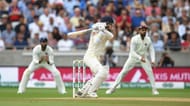
India begin their Test series against Australia at Adelaide on 6th December, and this is widely regarded as the best chance for them to register a maiden series win in the Kangaroo nation. The absence of the two best players from the opposition combined with a good bowling lineup in the visitors' team makes the contest very even.
Team India have been at the top of the ICC Test Rankings for a while now. They have thoroughly dominated all the teams during their home run of Tests, and look balanced enough in all departments to compete well across different conditions. Hence, prior to the tours of South Africa and England this year, they were expected to deliver great performances and achieve series triumphs.
However, despite being highly competitive and even occasionally in commanding positions on numerous occasions, India could not drive home the advantage. They lost the series 1-2 against South Africa and 1-4 against England.
While the series defeats were primarily owing to the failure of the batting lineup (apart from Virat Kohli) to complement the efforts of the bowlers (who picked up the 20 wickets in 6 out of 8 Tests), there were many tactical factors which contributed to changing the outcome of the matches.
In this article, let us have a look at such tactical factors which the captain and the management need to consider to improve their overseas record.
#1 Maintain a balance between stability and flamboyance
Ever since Kohli has assumed the mantle of captaincy, his approach has been to play an aggressive brand of cricket. He prefers bowlers with pace rather than mere line and length control, and has developed a good fast bowling unit.
In the batting department too, the players are being asked to bat freely. Strike rates are also considered for evaluating performances, even in the Test format.
While these things are definitely beneficial for the team, they have also resulted in some players having to tamper with their natural game - which in turn has hampered their performances. An example in this regard is Cheteshwar Pujara, who has often been at the receiving end for his defensive batting, and his place is always scrutinized after a few low scores.
On the other hand, stroke-makers like Rohit Sharma and Shikhar Dhawan are given opportunities on the basis of their magnificent records in the shorter formats.
On the away tours, the likes of Murali Vijay, Pujara and Ajinkya Rahane, with their defensive techniques, are immensely important to complement the brisk scoring of Kohli, Rohit and Rishabh Pant. Hence, the team management needs to strike a balance between solid and flamboyant players, especially on overseas tours.
#2 Be flexible with the team combination

While selecting the playing XI in Test cricket, the team combination holds great significance.
Unlike most of the previous Indian captains, Kohli has a preference for the five-bowler strategy. He has always harped on the importance of the bowling unit, as picking 20 opposition wickets is a must to emerge victorious.
The players in the current Indian team mostly have one-dimensional skills. The absence of part-time bowlers invariably forces the captain to pick five regular bowlers.
In order to get the right balance balance, India have tried utilizing Stuart Binny and Hardik Pandya in the all-rounder's role. But neither of those players has been able to make a significant contribution.
Considering the poor batting efforts in the recent away series, the team management should be flexible with the combinations and try opting for six specialist batsmen - at least for the initial matches of the series.
Previously too, during the New Zealand series at home, playing an extra batsman has proven beneficial.
#3 Make selections based on the conditions

The selection of the Test XI is a challenging and tricky process; the captain has to gauge the conditions over the five days and select the optimum team.
Kohli as a captain has not been averse to making changes, and has repeated the same playing XI just once during his four years at the helm. However, he has made some debatable selections considering the weather and pitch conditions.
Some of those instances include picking Kuldeep Yadav on a green Lord's track, not selecting Ravindra Jadeja on the turning Southampton pitch, and not playing an extra batsman on rank turners at Galle in 2015 and Pune in 2017.
India need to look into all the elements over the five days before finalizing the playing XI. The team selected should also be such that the toss does not become the only determinant of the result.
#4 Do not let a single partnership turn the match around

In recent series against England and South Africa, India were in dominating positions many times. But a couple of quickfire partnerships from the opponents turned out to be game-changing.
For example, the attacking knock that Sam Curran played at Edgbaston helped England recover from 87/7 to post 180.
A partnership can be built at any point in Test cricket, but the Indian team should be wary of giving away too many runs briskly. The salient feature of the Curran knock was the runs he scored in the third man region, which came off hard slashes or genuine edges.
Having attacking fields is necessary, but at least the areas where majority of the runs are scored should be covered.
Similarly, in the Southampton Test and the Cape Town Test, India could not maintain the upper hand and lost the matches by narrow margins.
The Australian conditions are more conducive for batting than England and hence, keeping a check on the run rate is paramount.
#5 Treat 'draw' as a result too

Test cricket has become result-oriented in recent times. Most of the matches get over within four days, with drawn games having become rare.
The current Indian captain and coach have constantly maintained that this team will always play with aggression and will not play for a draw. But that may not always be the wisest strategy.
In the Oval Test, with five wickets in hand going into the final session, Rishabh Pant played a slog just after KL Rahul got dismissed. He had Ravindra Jadeja, who scored a brilliant 86* in the first innings, for company, and could have gone for a draw.
Similarly, on Kohli's captaincy debut at Adelaide in 2014, India lost 8 wickets in the final session while going for a win.
On both the occasions, the team should have altered the initial approach after the fall of wickets. While aggression is necessary, what should also be taken into account that a draw is a better result than a loss - especially when there are only remote chances of a victory.
The gritty knock Parthiv Patel played on debut at Nottingham in 2002, Mahendra Singh Dhoni's 76* at Lord's in 2007, Gautam Gambhir's patient innings of 137 (436) at Napier in 2009 - these are some of the match-saving innings which are etched vividly in the memories of cricket fans.
Those drawn games paved the way for drawing or winning the series overseas, which is something that Kohli needs to consider on this tour Down Under.
Follow IPL Auction 2025 Live Updates, News & Biddings at Sportskeeda. Get the fastest updates on Mega-Auction and cricket news
